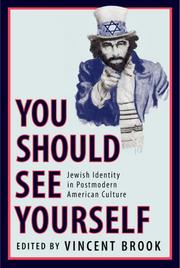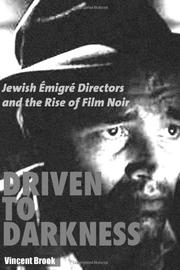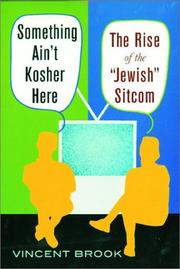| Listing 1 - 10 of 12 | << page >> |
Sort by
|

ISBN: 1281316547 9786611316549 081353996X 9780813539966 0813538440 0813538459 9780813538440 9780813538457 9781281316547 0813538440 9780813538440 661131654X Year: 2006 Publisher: New Brunswick, N.J. Rutgers University Press
Abstract | Keywords | Export | Availability | Bookmark
 Loading...
Loading...Choose an application
- Reference Manager
- EndNote
- RefWorks (Direct export to RefWorks)
The past few decades have seen a remarkable surge in Jewish influences on American culture. Entertainers and artists such as Jerry Seinfeld, Adam Sandler, Allegra Goodman, and Tony Kushner have heralded new waves of television, film, literature, and theater; a major klezmer revival is under way; bagels are now as commonplace as pizza; and kabbalah has become as cool as crystals. Does this broad range of cultural expression accurately reflect what it means to be Jewish in America today? Bringing together fourteen new essays by leading scholars, You Should See Yourself examines the fluctuating representations of Jewishness in a variety of areas of popular culture and high art, including literature, the media, film, theater, music, dance, painting, photography, and comedy. Contributors explore the evolution that has taken place within these cultural forms and how we can best explain these changes. Are variations in our understanding of Jewishness the result of general phenomena such as multiculturalism, politics, and postmodernism, or are they the product of more specifically Jewish concerns such as the intermarriage/continuity crisis, religious renewal, and relations between the United States and Israel? Accessible to students and general readers alike, this volume takes an important step toward advancing the discussion of Jewish cultural influences in this country.
Postmodernism --- Popular culture --- Jews in popular culture --- Religious aspects --- Judaism.

ISBN: 1280492430 9786613587664 0813548330 9780813548333 9780813546292 081354629X 9780813546308 0813546303 Year: 2009 Publisher: New Brunswick, N.J. Rutgers University Press
Abstract | Keywords | Export | Availability | Bookmark
 Loading...
Loading...Choose an application
- Reference Manager
- EndNote
- RefWorks (Direct export to RefWorks)
From its earliest days, the American film industry has attracted European artists. With the rise of Hitler, filmmakers of conscience in Germany and other countries, particularly those of Jewish origin, found it difficult to survive and fledùfor their work and their livesùto the United States. Some had trouble adapting to Hollywood, but many were celebrated for their cinematic contributions, especially to the dark shadows of film noir. Driven to Darkness explores the influence of Jewish TmigrT directors and the development of this genre. While filmmakers such as Fritz Lang, Billy Wilder, Otto Preminger, and Edward G. Ulmer have been acknowledged as crucial to the noir canon, the impact of their Jewishness on their work has remained largely unexamined until now. Through lively and original analyses of key films, Vincent Brook penetrates the darkness, shedding new light on this popular film form and the artists who helped create it.
Book
ISBN: 0813554586 1283717239 9780813554587 9780813554570 0813554578 9780813554563 081355456X 9781283717236 Year: 2013 Publisher: New Brunswick, N.J. Rutgers University Press
Abstract | Keywords | Export | Availability | Bookmark
 Loading...
Loading...Choose an application
- Reference Manager
- EndNote
- RefWorks (Direct export to RefWorks)
Unlike the more forthrightly mythic origins of other urban centers-think Rome via Romulus and Remus or Mexico City via the god Huitzilopochtli-Los Angeles emerged from a smoke-and-mirrors process that is simultaneously literal and figurative, real and imagined, material and metaphorical, physical and textual. Through penetrating analysis and personal engagement, Vincent Brook uncovers the many portraits of this ever-enticing, ever-ambivalent, and increasingly multicultural megalopolis. Divided into sections that probe Los Angeles's checkered history and reflect on Hollywood's own self-reflections, the book shows how the city, despite considerable remaining challenges, is finally blowing away some of the smoke of its not always proud past and rhetorically adjusting its rear-view mirrors. Part I is a review of the city's history through the early 1900's, focusing on the seminal 1884 novel Ramona and its immediate effect, but also exploring its ongoing impact through interviews with present-day Tongva Indians, attendance at the 88th annual Ramona pageant, and analysis of its feature film adaptations. Brook deals with Hollywood as geographical site, film production center, and frame of mind in Part II. He charts the events leading up to Hollywood's emergence as the world's movie capital and explores subsequent developments of the film industry from its golden age through the so-called New Hollywood, citing such self-reflexive films as Sunset Blvd., Singin' in the Rain, and The Truman Show. Part III considers LA noir, a subset of film noir that emerged alongside the classical noir cycle in the 1940's and 1950's and continues today. The city's status as a privileged noir site is analyzed in relation to its history and through discussions of such key LA noir novels and films as Double Indemnity, Chinatown, and Crash. In Part IV, Brook examines multicultural Los Angeles. Using media texts as signposts, he maps the history and contemporary situation of the city's major ethno-racial and other minority groups, looking at such films as Mi Familia (Latinos), Boyz N the Hood (African Americans), Charlotte Sometimes (Asians), Falling Down (Whites), and The Kids Are All Right (LGBT).
Popular culture --- Motion picture industry --- Culture, Popular --- Mass culture --- Pop culture --- Popular arts --- Communication --- Intellectual life --- Mass society --- Recreation --- Culture --- History. --- Los Angeles (Calif.) --- Hollywood (Los Angeles, Calif.) --- Los Anheles (Calif.) --- Pueblo de Nuestra Señora la Reina de los Angeles de Porciuncula (Calif.) --- Town of Our Lady the Queen of the Angels of Porciuncula (Calif.) --- Tʻien-shih-chih-chʻeng (Calif.) --- Tianshizhicheng (Calif.) --- Los Andzsheles (Calif.) --- Lo-shan-chi (Calif.) --- Loshanji (Calif.) --- Angeles (Calif.) --- Ciudad de Los Angeles (Calif.) --- Pueblo de Los Angeles (Calif.) --- Pueblo Los Angeles (Calif.) --- City of Los Angeles (Calif.) --- LA (Calif.) --- L.A. (Calif.) --- City of Angels (Calif.) --- لوس أنجلوس (Calif.) --- Lūs Anjilūs (Calif.) --- Los Anceles (Calif.) --- Горад Лос-Анджэлес (Calif.) --- Horad Los-Andz︠h︡ėles (Calif.) --- Лос-Анджэлес (Calif.) --- Los-Andz︠h︡ėles (Calif.) --- Лос Анджелис (Calif.) --- Los Andzhelis (Calif.) --- Λος Αντζελες (Calif.) --- Los Antzeles (Calif.) --- Los-Anĝeleso (Calif.) --- 로스앤젤레스 (Calif.) --- Losŭ Aenjellesŭ (Calif.) --- לוס אנג'לס (Calif.) --- Angelopolis (Calif.) --- Losandželosa (Calif.) --- Los Andželas (Calif.) --- Лос Анџелес (Calif.) --- Los Andželes (Calif.) --- ロサンゼルス (Calif.) --- Rosanzerusu (Calif.) --- ロサンゼルス市 (Calif.) --- Rosanzerusu-shi (Calif.) --- Los Anjeles (Calif.) --- Лос Андьелес (Calif.) --- Los Andʹeles (Calif.) --- Los Anxheles (Calif.) --- Лос Анђелес (Calif.) --- Our Lady Queen of the Angels (Calif.) --- Los Angeles City (Calif.) --- La La Land (Calif.) --- Social life and customs. --- Cultural pluralism --- Minorities --- Social conditions. --- In literature. --- In motion pictures. --- Ethnic minorities --- Foreign population --- Minority groups --- Persons --- Assimilation (Sociology) --- Discrimination --- Ethnic relations --- Majorities --- Plebiscite --- Race relations --- Segregation --- Cultural diversity --- Diversity, Cultural --- Diversity, Religious --- Ethnic diversity --- Pluralism (Social sciences) --- Pluralism, Cultural --- Religious diversity --- Cultural fusion --- Ethnicity --- Multiculturalism

ISBN: 0813532108 0813532116 Year: 2003 Publisher: New Brunswick (N.J.) : Rutgers university press,
Abstract | Keywords | Export | Availability | Bookmark
 Loading...
Loading...Choose an application
- Reference Manager
- EndNote
- RefWorks (Direct export to RefWorks)

ISBN: 9780813548333 9780813546292 Year: 2009 Publisher: New Brunswick, N.J. Rutgers University Press
Abstract | Keywords | Export | Availability | Bookmark
 Loading...
Loading...Choose an application
- Reference Manager
- EndNote
- RefWorks (Direct export to RefWorks)
Digital
ISBN: 9780813554587 9780813554570 Year: 2013 Publisher: New Brunswick, N.J. Rutgers University Press
Abstract | Keywords | Export | Availability | Bookmark
 Loading...
Loading...Choose an application
- Reference Manager
- EndNote
- RefWorks (Direct export to RefWorks)
Book
ISBN: 1611684811 161168479X 1306054710 1611684803 9781611684810 9781306054713 9781611684797 9781611684803 Year: 2014 Publisher: Waltham, Massachusetts
Abstract | Keywords | Export | Availability | Bookmark
 Loading...
Loading...Choose an application
- Reference Manager
- EndNote
- RefWorks (Direct export to RefWorks)
A critical assessment of Jewishness in Woody Allen's films and plays
Jews in popular culture --- Popular culture --- Religious aspects --- Judaism. --- Allen, Woody, --- Criticism and interpretation. --- Culture, Popular --- Mass culture --- Pop culture --- Popular arts --- Konigsberg, Allen Stewart, --- Konigsberg, Allan Stewart, --- Allen, Heywood, --- Allen, Vudi, --- Ален, Вудзі, --- Alen, Vudzi, --- Алън, Уди, --- Alŭn, Udi, --- Кьонигсберг, Алън Стюарт, --- Konigsberg, Alŭn Sti︠u︡art, --- Αλεν, Γούντι, --- Alen, Gounti, --- Κένιγκσμπεργκ, Αλεν Στιούαρτ, --- Keninksmpernk, Alen Stiouart, --- Аллен, Вуди, --- Aellŏn, Udi, --- 앨런, 우디, --- Alen, Ṿudi, --- Allens, Vudijs, --- Konigsbergs, Elens Stjuarts, --- Ален, Вуди, --- Кенигсберг, Ален Стјуарт, --- Kenigsberg, Alen Stjuart, --- ウディ・アレン, --- Aren, Udi, --- Конигсберг, Аллен Стюарт, --- Konigsberg, Allen Sti︠u︡art, --- Аллен, Вуді, --- Коніґсберґ, Аллен Стюарт, --- עלען, וואדי, --- 伍迪·艾伦, --- Ailun, Wudi, --- Communication --- Intellectual life --- Mass society --- Recreation --- Culture --- Allen, Woody --- Criticism and interpretation --- United States --- Judaism
Digital
ISBN: 9781612494784 Year: 2017 Publisher: West Lafayette Purdue University Press
Abstract | Keywords | Export | Availability | Bookmark
 Loading...
Loading...Choose an application
- Reference Manager
- EndNote
- RefWorks (Direct export to RefWorks)
Book
ISBN: 9781612494784 1612494781 9781557537638 1557537631 9781612494791 9781557537881 161249479X 1557537887 1612499090 Year: 2016 Publisher: Purdue University Press
Abstract | Keywords | Export | Availability | Bookmark
 Loading...
Loading...Choose an application
- Reference Manager
- EndNote
- RefWorks (Direct export to RefWorks)
The influence of Jews in American entertainment from the early days of Hollywood to the present has proved an endlessly fascinating and controversial topic, for Jews and non-Jews alike. From Shtetl to Stardom: Jews and Hollywood takes an exciting and innovative approach to this rich and complex material. Exploring the subject from a scholarly perspective as well as up close and personal, the book combines historical and theoretical analysis by leading academics in the field with inside information from prominent entertainment professionals. Essays range from Vincent Brook's survey of the stubbornly persistent canard of Jewish industry "control" to Lawrence Baron and Joel Rosenberg's panel presentations on the recent brouhaha over Ben Urwand's book alleging collaboration between Hollywood and Hitler. Case studies by Howard Rodman and Joshua Louis Moss examine a key Coen brothers film, A Serious Man (Rodman), and Jill Soloway's groundbreaking television series, Transparent (Moss). Jeffrey Shandler and Shaina Hamermann train their respective lenses on popular satirical comedians of yesteryear (Allan Sherman) and those currently all the rage (Amy Schumer, Lena Dunham, and Sarah Silverman). David Isaacs relates his years of agony and hilarity in the television comedy writers' room, and interviews include in-depth discussions by Ross Melnick with Laemmle Theatres owner Greg Laemmle (relative of Universal Studios founder Carl Laemmle) and by Michael Renov with Mad Men creator Matthew Weiner. In all, From Shtetl to Stardom offers a uniquely multifaceted, multimediated, and up-to-the-minute account of the remarkable role Jews have played in American movie and TV culture.
Television broadcasting --- Motion picture industry --- Jews on television --- Jews in the motion picture industry --- Jews in television --- Television --- Telecasting --- Television industry --- Broadcasting --- Mass media --- History --- Hollywood (Los Angeles, Calif.) --- United States --- History. --- Civilization --- Jewish influences. --- E-books --- Jews in television broadcasting --- American Jews --- Jews --- Judaism
Digital

ISBN: 9780813564555 9780813564548 Year: 2014 Publisher: New Brunswick, N.J. Rutgers University Press
Abstract | Keywords | Export | Availability | Bookmark
 Loading...
Loading...Choose an application
- Reference Manager
- EndNote
- RefWorks (Direct export to RefWorks)
| Listing 1 - 10 of 12 | << page >> |
Sort by
|

 Search
Search Feedback
Feedback About UniCat
About UniCat  Help
Help News
News